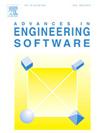Optimal Tool Path Planning in Five-Axis Flank Milling for Cylindrical Cutters using Surrogate Models and Multi-Level Space Reduction Techniques
IF 4
2区 工程技术
Q2 COMPUTER SCIENCE, INTERDISCIPLINARY APPLICATIONS
引用次数: 0
Abstract
Precise error control in 5-axis flank milling of complex surfaces through optimal tool path planning is a challenging task. The solution process usually involves a large number of decision variables in a highly nonlinear search space. The performance of previous meta-heuristic algorithms on this problem has been unsatisfactory, largely due to the curse of dimensionality. This paper proposes a computational scheme for generating optimal tool paths based on multi-level space reduction techniques integrated with surrogate models. A global model is first constructed to offer an approximation to the actual solution landscape that facilitates quick identification of a potential global optimal area. Next, a local model is created around the optimal area to estimate more accurate solutions. This two-step process can repeat for multiple iterations until a satisfactory solution is achieved. We compare how different surrogate modeling methods and sampling techniques influence the optimization process based on the scheme. Test results on representative surfaces show that it outperforms other methods in terms of both solution quality and search efficiency. This work provides an effective approach for enhancing geometric accuracy in five-axis flank milling.
使用代用模型和多级空间缩减技术优化圆柱形铣刀五轴侧面铣削的刀具路径规划
本文章由计算机程序翻译,如有差异,请以英文原文为准。
求助全文
约1分钟内获得全文
求助全文
来源期刊

Advances in Engineering Software
工程技术-计算机:跨学科应用
CiteScore
7.70
自引率
4.20%
发文量
169
审稿时长
37 days
期刊介绍:
The objective of this journal is to communicate recent and projected advances in computer-based engineering techniques. The fields covered include mechanical, aerospace, civil and environmental engineering, with an emphasis on research and development leading to practical problem-solving.
The scope of the journal includes:
• Innovative computational strategies and numerical algorithms for large-scale engineering problems
• Analysis and simulation techniques and systems
• Model and mesh generation
• Control of the accuracy, stability and efficiency of computational process
• Exploitation of new computing environments (eg distributed hetergeneous and collaborative computing)
• Advanced visualization techniques, virtual environments and prototyping
• Applications of AI, knowledge-based systems, computational intelligence, including fuzzy logic, neural networks and evolutionary computations
• Application of object-oriented technology to engineering problems
• Intelligent human computer interfaces
• Design automation, multidisciplinary design and optimization
• CAD, CAE and integrated process and product development systems
• Quality and reliability.
 求助内容:
求助内容: 应助结果提醒方式:
应助结果提醒方式:


